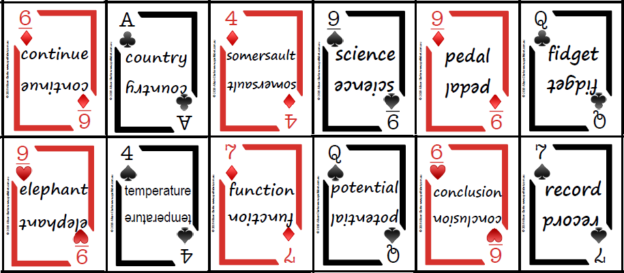More phonics playing cards
3 Replies
We have a new set of download-and-print decks of phonics playing cards, this time targeting more advanced spelling patterns. The cards are still child-sized (5 X 6.5cm) with words facing both up and down, making them easy to read from either side of a table.
The first few decks each target one sound (phoneme) spelt multiple ways:
- “you” as in “music”, “argue”, “dune”, “stew”, “Europe”, “view”, “beauty”, “nuisance”, and “vacuum”.
- “u” as in “much”, “front”, “cousin”, “blood”, and “does”.
- “o” as in “doll”, “swamp”, “fault”, and “cough”.
- “s” as in “since”, “cent”, “purse”, mess”, “scene”, and “whistle”.
- “l” as in “later”, “grill”, “beetle”, “final”, “model”, “lentil”, and “idol” (linguistics purists, these words contain only syllabic /l/ after an alveolar stop).
- “j” as in “joint”, “legend”, “large”, “judge”, and “adjust”.
- “f” as in “drift”, “effect”, “graph”, “laugh” and “sapphire”.
Then there are four decks of words with Latin suffixes, and thus similar-sounding final syllables:
- “ture” as in “future”, “signature” and “agriculture”.
- “tion” as in “action”, “tion” as in “Egyptian”, “sion” as in “tension”, “ssion” as in “obsession”, and “cian” as in “politician”.
- “tia” as in “inertia”, “tial” as in “essential”, “tious” as in “cautious”, “tient” as in ‘patient”, “cia” as in “acacia”, “cial” as in “facial”, “cious” as in “gracious”, “sia” as in “aphasia”, “xious” as in “noxious”.
- “sion” as in “decision” and “sure” as in “pleasure”.
There is also one deck of homographs, which have more than one pronunciation, as in “row”, “tear”, “console”, “moped”, “second”, and “rebel”. These can be helpful in teaching about the role word stress can play in determining meaning.
The decks are cheaper if bought as a set of twelve, and cheaper again if you use the covid-19 coupon code. You get change from AUD$10 for the set.
These cards can be used as part of most phonics/morphology-based reading/spelling teaching sequences, but most closely follow the teaching sequence used in the Phonic Books Talisman 2 and Titan’s Gauntlets series of books, and the Sounds-Write synthetic phonics program.
We suggest printing them on A4 200gsm cardboard, and if you plan to use them a lot, laminate them. Cutting them up is great scissor skills practice for children, or do it while watching more-telly-than-usual, then use the result for some good old-fashioned, low-tech fun at home.
These cards can be used to play any card game requiring a typical deck of playing cards, but players must read the cards’ words as they play them. We’ve made some videos of example games to get you started, click on the links below to watch them:
California Speed Spit Snip Snap Snorum Beggar Thy Neighbour War Slapjack Snap Mancala (get our Mancala board here)
We’ve improved the format of the cards since making these videos. If you’re looking for more/different games, an internet search for “kids’ playing card games” brings up lots, including videos showing how to play.
These cards can also be used for sorting activities, grouping the same spellings, eyeballing the groups and noticing/discussing how/where each spelling is used. I also use them as a source of randomly-selected spelling quiz words, once we’ve studied the target spellings and learners have used them often enough to learn them.
Caitlin Stephenson had the brilliant, original idea for these cards, Renee Vlahos did the layout and spent hours making our sets, and Tessa Weadman’s hand model hands appear in some of the above videos. Thanks once again to them, and all the Spelfabet team, for their great ideas, hard work and enthusiasm.



Thanks so much Alison & co. Another brilliant resource that will be a great addition to our spelling program
Thanks for the lovely feedback! Alison
Thank you